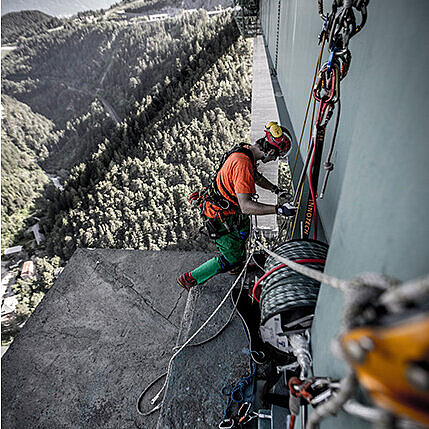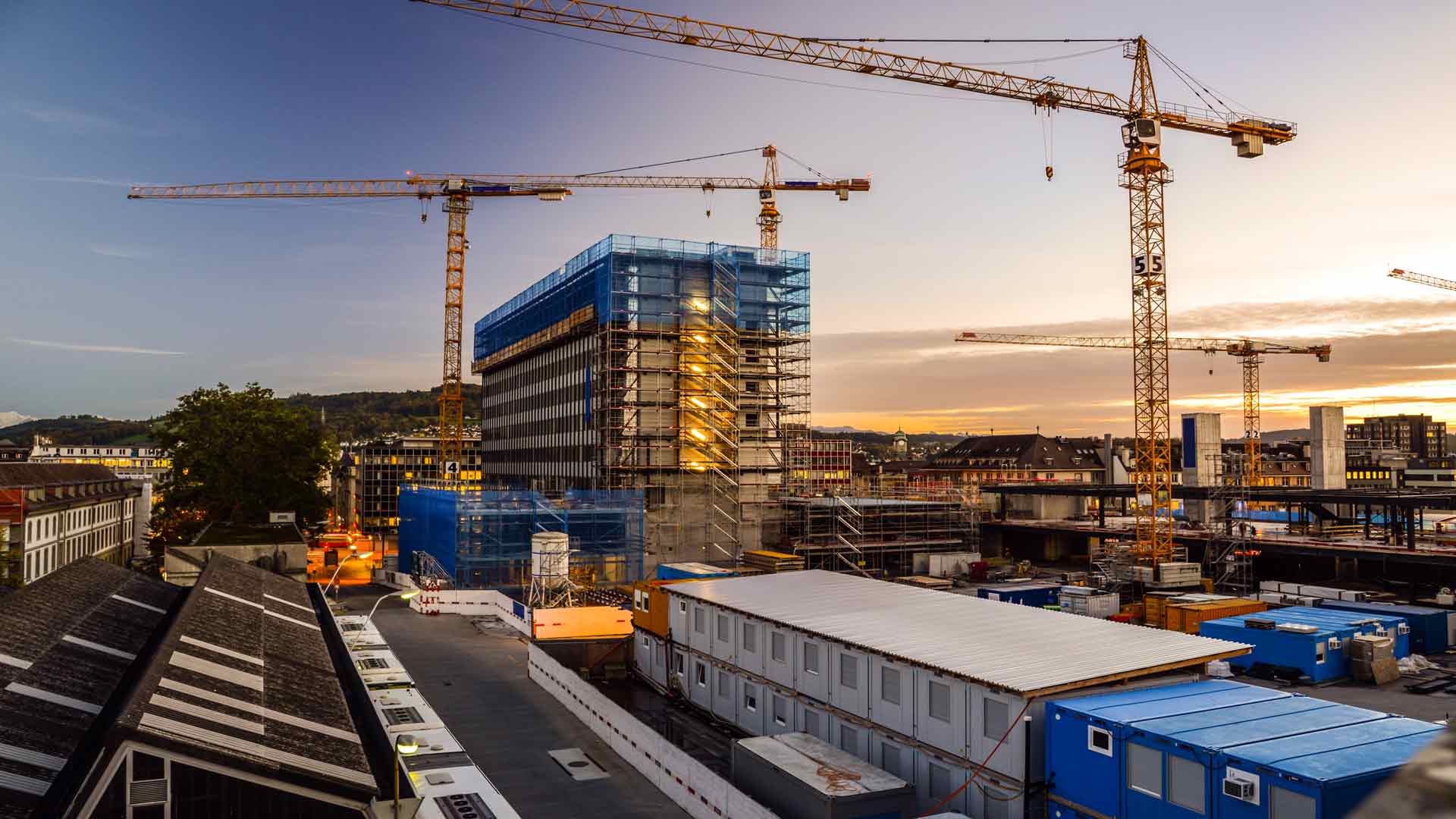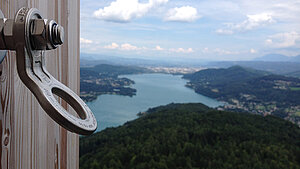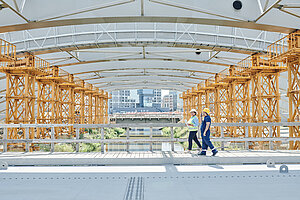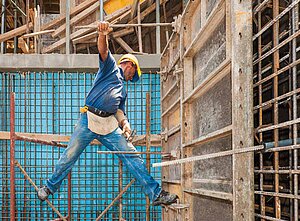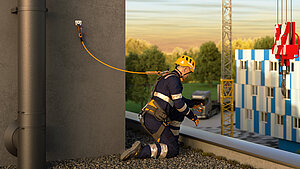There are jobs, e.g. in industry or construction, that involve moving and, thus properly securing, heavy loads. Safety equipment is furthermore used for people who carry out servicing or maintenance work in fall-risk areas, such as on façades, roofs, and wind or hydro-electric power plants.
All these areas are counted among workplaces with an elevated safety risk that are subject to laws stipulating that construction site operators or employers secure these areas. Pivotal to this effort are “fasteners and anchorage equipment.” The former serve as a link between the single anchor point on the load-bearing structure and the load – in our case, a human being. The latter comprises various straps, slings, chains, etc. that are used for transporting materials. However, the definition of anchorage equipment also extends to anchor points that play their part in a fall protection system.
This post will reveal what type of anchorage equipment is used in which case, how anchorage equipment differs from a fastener, and which factors need to be considered for the maintenance of this safety equipment.
“Anchorage equipment is composed of devices that are not part of the hoists, but establish a connection between the support element and the load or the support element and the lifting equipment. [...] The design and dimensions of support elements and anchorage equipment must be sufficient to provide safety during operation and under the loads generated during operation.” (Wikipedia)
Examples of anchorage equipment
Mobile load handling requires different work equipment than static load handling. Another factor is the different level of load bearing capacity. The choice of the equipment varies with the occurring loads.
- A safety rope is usually made of high-strength polyamide or polypropylene and offers flexibility at work in addition to a high load capacity.
- A chain (or chain slings) made of high-strength steel is usually used for lifting heavy equipment as well as in industrial environments.
- Lifting straps are made of high-strength polyester and are particularly suitable for load lifting jobs requiring flexibility and lightness thanks to their low weight.
- Lifting belt slings are special belts made of polyester fabric, which are well suited for the flexible transport of loads in different working environments.
- Round slings made of high-strength nylon or polyester offer a high degree of flexibility and load-bearing capacity. They are also a common choice for difficult positions.
- Detachable connecting parts are connecting links between different anchorage equipment or loads made of steel or aluminium which are easy to adjust and can be configured as required.
Depending on the anchorage process, a further distinction must be made between two types of anchorage equipment: screw on and weld-on equipment, both of which are available in different stability classes as rotating and non-rotating versions. In-depth training of the workforce is of crucial importance as it ensures the correct use of the anchorage equipment that is most suitable in each case.
Additional links for the DACH region:
AUVA: 12-part poster series “Attaching loads securely!”
DGUV: “Anchorage equipment”
SUVA: “Checklist: Using anchorage equipment safely and properly”
High-quality anchorage equipment in fall protection
Even a fall protection system of the highest quality will fail if the anchorage equipment does not withstand the forces generated during a fall. When part of a fall protection system, an anchor point serves as anchorage equipment. The user attaches themselves to the personal protective equipment at the anchor point and is thus protected against a fall.
In contrast to the fastener, anchorage equipment has no energy-absorbing effect! This means that energy absorbers for the reduction of the impact force during a fall are only found on fasteners. This is the main difference that must be understood in the context of fall protection systems.
Anchorage equipment vs. fasteners in fall protection
Work equipment designed for transporting loads, such as lifting belt slings, round slings, etc., are not used for the purpose of fall protection. As they have no energy-absorbing effect, these items are unable to offset the forces generated during a fall! However, the common definition classifies the anchor point in the fall protection category under the designation of anchorage equipment.
Anchorage equipment used for transporting loads is not suitable for securing people working in a fall-risk area! Instead, it is mandatory to pick a fastener that has been approved for use in fall protection. It serves as a link between the worker in their personal protective equipment against falls from a height (anti-fall PPE) and the respective anchor point.
The most common fasteners are:
- Fall arrest devices: These are used in the overhead applications and work similarly to a car belt by “stopping” the fall. Adjusted permanently to the correct length, the rope practically possesses an automatic protective effect.
- Adjustable lanyards: Contrary to fall arrest systems (FAS for short), other fasteners offer the option of setting and adjusting the length manually in order to ensure protection. They consist of carabiners for hooking yourself into the anchorage equipment and of an energy absorber and a rope plus carabiners for hooking yourself into the safety harness or restraint belt.
Another key factor in avoiding the risk of a fall is edge protection. If the fastener glides over an edge in the event of a fall, it is subjected to a tremendous load and may tear due to chafing. If edges are in the fall-risk area, this aspect needs to be factored into the choice of the protective equipment. PSA-SHARK, for instance, possesses a steel core and the sharp edge test, thus providing perfect protection for this type of application.

PPE LANYARDS
PERSONAL PROTECTIVE EQUIPMENT PPE
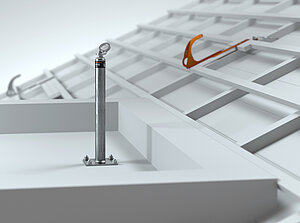
Anchor Points EAP / SDH
Secure connection of system/anchorage eye to substructure
Because of the very wide variety in fall-risk areas, individual forms of fall protection are necessary.
Servicing and testing
In order to ensure optimal safety, it is crucial to regularly service the fall protection components and all anchorage equipment used and to check them according to the manufacturer's specifications. Only competent persons should carry out the inspection and create a comprehensive documentation of the results. Fasteners and anchorage equipment without a manufacturer identification code are taboo!
It is furthermore imperative to correct any signs of wear or damage without delay. It is sometimes necessary to replace the corresponding equipment - examples of such incidents include broken strands, cuts in fabric or worn-out chain links. Observe the so-called discard criteria that apply to anchorage equipment.
Equally important for an effective fall protection system are the careful storage and correct use of the anchorage equipment. Failure to take these precautions may not only cause personal harm but also have legal ramifications. Worse yet, you could also lose your insurance coverage.
Pay attention to the following:
- Manufacturer identification code
- Maximum permissible load capacity / number of people
- Visual inspection prior to every use
- Edge protection: Ropes and lifting straps must not be pulled unprotected over sharp-edged profiles, as they may otherwise become damaged or tear.
- Dry and airy storage to provide for protection against weather influences and aggressive substances
